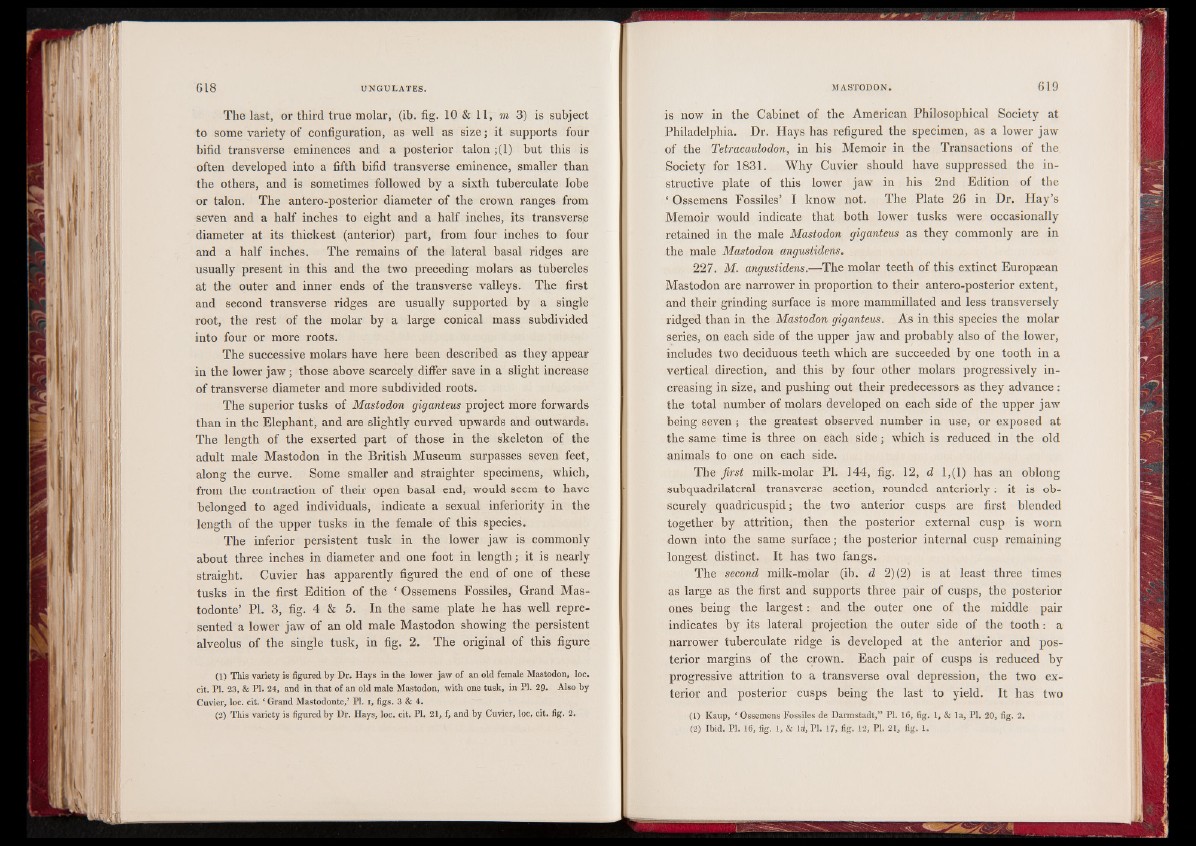
The last, or third true molar, (ib. fig. 10 & 11, m 3) is subject
to some variety of configuration, as well as size; it supports four
bifid transverse eminences and a posterior talon ;(1) but this is
often developed into a fifth bifid transverse eminence, smaller than
the others, and is sometimes followed by a sixth tuberculate lobe
or talon. The antero-posterior diameter of the crown ranges from
seven and a half inches to eight and a half inches, its transvers.e
diameter at its thickest (anterior) part, from four inches to four
and a half inches. The remains of the lateral basal ridges are
usually present in this and the two preceding molars as tubercles
at the outer and inner ends of the transverse valleys. The first
and second transverse ridges are usually supported by a single
root, the rest of the molar by a large conical mass subdivided
into four or more roots.
The successive molars have here been described as they appear
in the lower jaw; those above scarcely differ save in a slight increase
of transverse diameter and more subdivided roots.
The superior tusks of Mastodon giganteus project more forwards
than in the Elephant, and are slightly curved upwards and outwards.
The length of the exserted part of those in the skeleton of the
adult male Mastodon in the British Museum surpasses seven feet,
along the curve. Some smaller and straighter specimens, which,
from the contraction of their open basal end, would seem to have
belonged to aged individuals, indicate a sexual inferiority in the
length of the upper tusks in the female of this species.
The inferior persistent tusk in the lower jaw is commonly
about three inches in diameter and one foot in length; it is nearly
straight. Cuvier has apparently figured the end of one of these
tusks in the first Edition of the ‘ Ossemens Fossiles, Grand Mas-
todonte’ PL 3, fig. 4 & 5. In the same plate he has well represented
a lower jaw of an old male Mastodon showing the persistent
alveolus of the single tusk, in fig. 2. The original of this figure
(1) This variety is figured by Dr. Hays in the lower jaw of an old female Mastodon, loc.
cit. PI. 23, & PI. 24, and in that of an old male Mastodon, with one tusk, in PI. 29. Also by
Cuvier, loc. cit. ‘ Grand Mastodonte,’ PI. I, figs. 3 & 4.
(2) This variety is figured by Dr. Hays, loc. cit. PI. 21, f, and by Cuvier, loc, cit. fig. 2.
is now in the Cabinet of the American Philosophical Society at
Philadelphia. Dr. Hays has refigured the specimen, as a lower jaw
of the Tetracaulodon, in his Memoir in the Transactions of the
Society for 1831. Why Cuvier should have suppressed the instructive
plate of this lower jaw in his 2nd Edition of the
‘ Ossemens Fossiles’ I know not. The Plate 26 in Dr. Hay’s
Memoir would indicate that both lower tusks were occasionally
retained in the male Mastodon giganteus as they commonly are in
the male Mastodon angustidens.
227. M. angustidens.—The molar teeth of this extinct European
Mastodon are narrower in proportion to their antero-posterior extent,
and their grinding surface is more mammillated and less transversely
ridged than in the Mastodon giganteus. As in this species the molar
series, on each side of the upper jaw and probably also of the lower,
includes two deciduous teeth which are succeeded by one tooth in a
vertical direction, and this by four other molars progressively increasing
in size, and pushing out their predecessors as they advance :
the total number of molars developed on each side of the upper jaw
being seven; the greatest observed number in use, or exposed at
the same time is three on each side; which is reduced in the old
animals to one on each side.
The first milk-molar PL 144, fig. 12, d 1,(1) has an oblong
subquadrilateral transverse section, rounded anteriorly: it is obscurely
quadricuspid; the two anterior cusps are first blended
together by attrition, then the posterior external cusp is worn
down into the same surface; the posterior internal cusp remaining
longest distinct. It has two fangs.
The second milk-molar (ib. d 2) (2) is at least three times
as large as the first and supports three pair of cusps, the posterior
ones being the largest: and the outer one of the middle pair
indicates by its lateral projection the outer side of the tooth: a
narrower tuberculate ridge is developed at the anterior and posterior
margins of the crown. Each pair of cusps is reduced by
progressive attrition to a transverse oval depression, the two exterior
and posterior cusps being the last to yield. It has two
(1) Kaup, 1 Ossemens Fossiles de Darmstadt,” PI. 16, fig. 1, & la, PI. 20, fig. 2.
(2) Ibid. PI. 16, fig. 1, & la!, PI. 17, fig. 12, PI. 21, fig. 1.